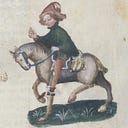Member-only story
Elizabeth Barton: Holy Nun or Mad Maid?
When one thinks of the notable figures of the English Reformation, a few names come to mind. Aside from monarchs, they likely include Thomas More, John Fisher, Stephen Gardiner, Reginald Pole, Thomas Wolsey, Thomas Cranmer, and Thomas Cromwell, amongst others. Thinking of female figures, and besides the obvious Mary I, a few (or none) might spring to mind. The Guernsey Martyrs, Anne Askew, and a few other women are usually the most well known. Despite her wit, influence over the King, and symbolism as an act of resistance against a tyrant, few people would think of Elizabeth Barton, the ‘Holy Nun of Kent’.
Barton was executed on this day 485 years ago, on the 20th of April 1534, alongside Edward Bocking, John Dering, Henry Gold, Hugh Rich, and Richard Risby. What separates Barton from these men, all of whom were clergymen, is more than just her gender. A woman in mid-Tudor England, Barton outshone them all in her popularity, notoriety, and position as a greatly influential religious figure.
Barton’s early life — up until 1525 — saw little out of the ordinary occur. She was a servant at the household of Thomas Cobb, himself a steward of an estate owned by the Archbishop of Canterbury, William Warham. It was when she was 19 years old that her trances began. Likely arising from an illness she had (possibly epilepsy), her murmurings and religious claims…
